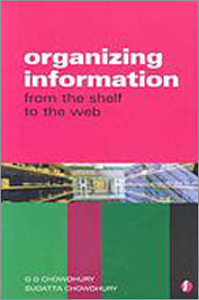
Primary tabs
You don't need to be an ALA Member to purchase from the ALA Store, but you'll be asked to create an online account/profile during the checkout to proceed. This Web Account is for both Members and non-Members.
If you are Tax-Exempt, please verify that your account is currently set up as exempt before placing your order, as our new fulfillment center will need current documentation. Learn how to verify here.
- Description
- Table of Contents
- Reviews
Today's library and information professionals must be conversant with organizing all forms of information -- from books on the shelf to objects in digital libraries to websites. This innovative new text guides readers through the organization of the broad spectrum of information. Coverage includes cataloging and classification; metadata; information architecture; bibliographic formats; subject indexing and vocabulary control; organization of digital information; mark-up languages; and more. This new text is ideally suited for library and information science courses or as a resource for professionals who need to understand the various tools and techniques necessary to master information organization.
1. Organizing information: what it means
- Organization of information: what and why?
- Classification
- Purpose of classification
- Cataloguing
- Purpose of cataloguing
- Library approaches to organizing information
- About this book: why this book and for whom
- Summary
- Review questions
- References
2. Information organization in different non-library environments
- Introduction
- The online database approach
- The DBMS approach
- The expert systems approach
- Organization of information on the internet
- New approaches to organizing information on the intranet and web
- The semantic web
- Summary
- Review questions
- References
3. Cataloguing
- Introduction
- What is a library catalogue?
- AACR2
- The process of cataloguing
- Subject access to catalogues
- Implications of basic cataloguing rules on OPACs
- Cataloguing of internet resources
- FRBR (Functional Requirements of Bibliographic Records)
- Entities and their relationships
- Importance of the FRBR Model
- Summary
- Review Questions
- References
4. Bibliographic formats: MARC21 and others
- Bibliographic formats
- ISO 2709: format for bibliographic information interchange
- MARC format
- MARC 21
- UNIMARC format
- CCF
- Summary
- Review questions
- References
5. Library classification
- What is library classification and why?
- Classification schemes
- Types of bibliographic classification schemes
- Major library classification schemes
- Dewey main classes
- Classification of electronic resources
- Summary
- Review questions
- References
6. Subject heading lists and thesauri in information organization
- Vocabulary control tools
- Subject heading lists and thesauri
- Thesauri
- Subject headings lists and thesauri in the organization of internet resources
- Summary
- Review Questions
- References
7. Organization of internet information resources
- Typical characteristics of web information resources
- Metadata: why not bibliographic formats?
- Bibliographic classification schemes: are they suitable for organizing the web?
- Subject heading lists: limitations for indexing internet resources
- New tools and standards for managing internet information
- The semantic web
- Summary
- Review questions
- References
8. Metadata
- Metadata – what?
- Metadata – why?
- Metadata – types
- Metadata standards
- Dublin Core
- Other metadata standards
- ISAD and EAD
- TEI
- Metadata management
- Summary
- Review questions
- References
9. Markup languages
- SGML
- HTML
- XML: origin and meaning
- XML: what for?
- HTML vs XML
- Characteristics of XML
- XML documents
- DTD and XML Schema
- Summary
- Review questions
- References
10. Ontology
- Ontology: origin and meaning
- Ontology, taxonomy, and thesaurus
- Some common examples of ontology
- Ontologies: what do they do?
- Building an ontology: guidelines and methods
- Tools for building ontology
- Ontology languages: DAML+OIL and OWL
- OWL
- Ontology: role in information organization and management
- Summary
- Review questions
- References
11. Information architecture
- What is IA?
- Why do we need an IA?
- IA: what does it involve?
- How to Build an IA?
- Building an IA: approaches and stages
- Outcome of an IA exercise
- Summary
- Review questions
- References
12. The Semantic web
- What is the Semantic Web?
- How does the Semantic web differ from the conventional web?
- The semantic web technologies
- URI – uniform resource identifier
- RDF
- Semantic web applications
- Semantic web and information access
- Summary
- Review questions
- References
13. Information organization: issues and trends
- Cataloguing: FRBR and semantic catalogue network
- Metadata
- Classification in the digital age
- Ontologies
- Semantic portals and ontologies
- Semantic web technologies and digital libraries
- User-driven classification of web resources
- Conclusion
- References
"This is a very thorough review of the area, and currency is very good."--MMIT
"The Chowdhurys have provided a detailed and up-to-date text book on organizing information in the digital era. The content is of immense practical value for librarians and information professionals involved in both traditional and digital libraries."--Library Collections, Acquisitions and Technical Services
"Sudatta and G.G. Chowdhury have written a quirky little textbook that excels in its substantive coverage … This book is well worth a thorough reading."--Legal Information Alert


